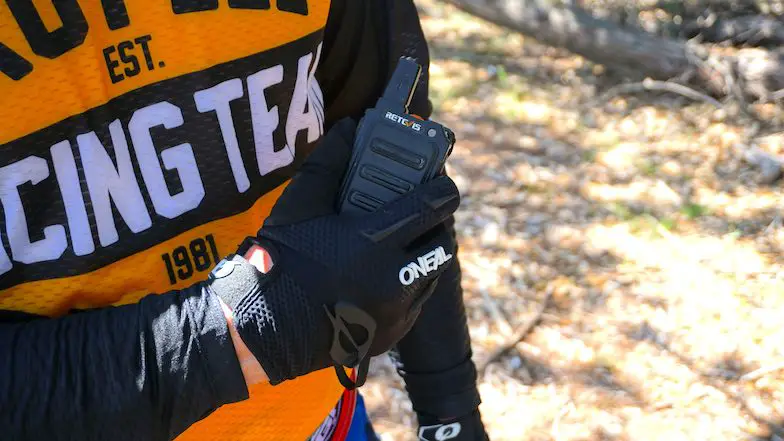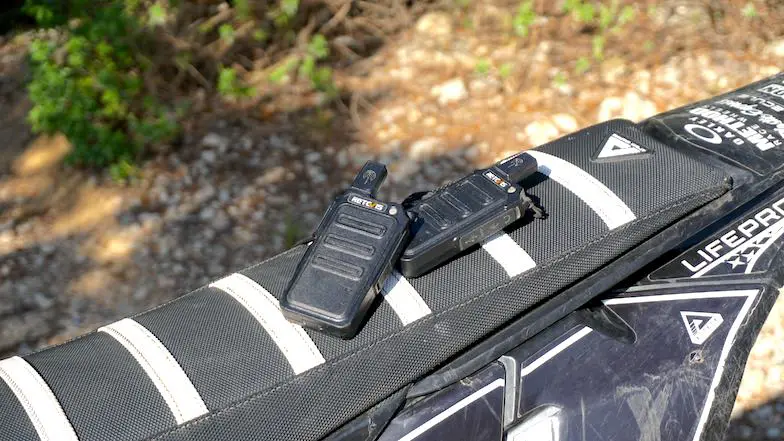Dirt bike radios are a great way to communicate with your trail riding group. No more need to yell to riding buddies with your helmet on. Dirt bike walkie talkies help keep the group together, find lost riders, and share the fun and amazing views together.
The best dirt bike radios are small and durable. Additionally, they can be used with gloves on without additional wiring or external buttons. 1 to 2 mile range usually works wells in most trail riding conditions with your riding group. Back to camp calls usually do require more range from the walkie talkies.
We wanted to share our experiences with radios, helmet installed headsets, and walkie talkie style handheld options for dirt bikes. The same radio options work well both in trail riding, adventure riding, and motocross.
We cover topics, such as:
This post contains affiliate links. If you use these links to buy something we may earn a commission at no additional cost to you. As an Amazon Affiliate we earn from qualifying purchases.
Benefits of Using a Dirt Bike Radio
Dirt bike riding has a lot to do with being able to explore the nature and the great views it offers. Still, these fantastic locations often equal to no cell coverage. Furthermore, using small, portable, and easy-to-use walkie talkie style dirt bike radios will make riding much more enjoyable!
Additional communication methods are beneficial in many other situations when you are riding dirt bikes. Let’s take a closer look at typical scenarios for using a radio for dirt bikes in general.

Read also: Single track riding tips for beginners
Radio Helps With Organizing a Larger Group Ride
Larger groups tend to have a mix of faster and slower riders with different skill levels. Generally, this makes navigation and keeping the group together much more difficult.
Walkie talkies or radios help with navigating the trails. They also help in notifying the riders about upcoming dangers or road crossings. Keeping the group together and on the same track is another benefit of using dirt bike radio communication. They will also help to minimize the stops along the way.
Having a radio for the lead and the sweep riders will make the group ride experience much smoother.

Packing a Radio When Riding Solo
We do not recommend riding alone. But if you must, radio communications can help to keep an open line between the camp and the rider.
Contacting people in case of an emergency, getting lost, or having any technical issues is crucial. Obviously, it can help save the day in various conditions.
Coaching and Teaching Situations Can Benefit From Using Radios
Surely, 2-way radios can help in many coaching and teaching scenarios.
When teaching a friend or your kid or spouse to learn dirt bike riding, a radio can really help. Besides, we all know how difficult it is to hear other riders with the engines running and helmets on.

Choosing the Best Dirt Bike Radio to Fit Your Needs and Riding Style
In short, the best dirt bike communication system is the one being used the most.
Trail riding and enduro is different from street riding. The radio that is working well in street riding is likely not going to be the best for trail riding.
Consequently, the choice depends on what the primary use for the radio is. When that is determined, focus on the form factor (size and weight) and the ease of use.
Available Dirt Bike Walkie Talkies for Trail Riding
Basically, there are two main categories to choose from. A handheld dirt bike radio strapped into your gear or a walkie talkie for dirt bike helmet with a headset.
Next, let’s dive into details of these options.
Handheld Type Radios
Certainly, a small, compact, and durable handheld radios are definitely a great option. Additionally, you have plenty of options to choose from, including models that offer a great variety of accessories.
In our experience, small rugged waterproof radios work very well for most single track and enduro riding. Typically, talking to someone means stopping trailside and focusing on the discussion. In short, the radio needs to be fairly accessible, easily attachable to gear, and easy to use with gloves on.
Many of the handheld dirt bike radio options are about the size of a smart phone. Furthermore, most offer various mounting options. Our favorite is a heavy duty clip to strap the radio to a hydration backpack, a roost plate, or a fanny pack.
We think the best walkie talkie for dirt bike riding is Retevis RT19 Walkie Talkie (click to check the current price on Amazon.com).
It is a walkie talkie style lightweight radio for dirt bike riding that easily straps to your gear. It has an acceptable range, a small size, it’s light and durable with decent weather and dust protection.
Pros and Cons of Handheld Dirt Bike Radios
| PROS | CONS |
|---|---|
| No installation required | No great hands-free options, ear pieces are now available |
| Multiple mounting options | |
| No wiring or modules that can get snagged | |
| Plenty of accessories available | |
| Affordable |
Helmet Installed Dirt Bike Radio Options
For hands-free operation, you can consider helmet installed radios. Surely, you have seen similar options on the street riding world. Some models install directly to the side of the helmet. Additionally, they include a speaker and a microphone that are installed inside the helmet.
Typical installation options include a module installed directly to the side of the helmet. The external microphone and speakers are installed either inside the helmet with wire connectors or using bluetooth technology.
In our testing, we have found that most of the helmet speakers are uncomfortable in long term use. Enduro helmets are light, narrow, and heavily padded on the inside. The speakers and microphone inside the helmet can put pressure around your ears and cheeks and quickly become uncomfortable. Surprisingly, we have yet to find a good inside the helmet option that would work for us.
Firstly, we recommend a radio with a standard headphone jack option and a bluetooth connectivity, such as this Rugged OFF ROAD Helmet Kit Headset (click to check the current price on Amazon.com). Secondly, test the helmet speaker configurations and microphone options that best fit your helmet model. Small, smart phone style headphones will probably work well.
Push to Talk or Speech Recognition Options May Help
You can also test with different style speech recognition enabled radios. Additionally add a handlebar mounted push button option to begin talking, just like in this Rugged Radios Handheld Radio (click to check the current price on Amazon.com). Many speech recognition radios will turn on when riding and revving the dirt bike or breathing heavily inside the helmet. This will quickly start annoying anyone on the receiving end of the enduro radio.
Pros and Cons of Helmet Installed Enduro Radios
| PROS | CONS |
|---|---|
| Push to talk and speech recognition options | Wiring can get easily snagged and break |
| Inside helmet speakers are louder and can be heard while riding | Modules installed outside the helmet can snag on branches pulling your helmet and cause injury or crash |
| Plenty of accessories available | Higher price point |
| Can simultaneously listen to music | Speakers inside the helmet can be uncomfortable |
| More range options | Low range for bluetooth only models |
Price Points for Dirt Bike Radios
Handheld radios definitely have the most available options for any price point. That is partly why we recommend the handheld enduro radios for trail riding. Also, they start from about $20 and up. They are a great option for most riders looking to buy radios for enduro style single track riding.
The helmet installed enduro radio options are pricier. However, they are more feature-rich and come with a variety of options for speaker and microphone installation. The typical models start from $150 and up and they usually include a pair for two riders.
Be cautious when looking at the range of the helmet installed enduro radios. Additionally, many models offer only bluetooth connectivity, which is not enough for trail riding.
Read also: Single track riding tips for beginners
Minimum Features for a Good Dirt Bike Radio
When choosing the best trail riding dirt bike radio for your needs, you should look for the following features.
At the bare minimum, your radio should come with an appropriate range. It should also have at least some weatherproofing properties, and it should be easy to use.

Range
Think of the primary use for the radio. Are you riding solo and need the radio to carry back to camp? Do you ride in the mountains or on a track around the backyard? Many things will affect the overall range in most radios for dirt bikes. However one thing is certain: you need more range on the trails because of the terrain affects the range.
Many radio manufacturers claim several miles of range but in real life, the range is heavily limited by obstacles. Typically, one mile range can easily be a quarter mile on the trails.
If wish to talk with riders in your group, pick a radio with a range between 0.5 to 1 mile. This is plenty of range when you plan to ride with the group and find lost friends near your location.
Weatherproofing
Riding enduro means that dirt, dust, mud, and water will travel everywhere. This also applies to radios, so you want to consider this when selecting the radio.
For an easy access and ease of use, the enduro radio usually sits uncovered and exposed to weather elements. Additionally, consider the waterproofed models. Also, plan ahead how to protect the unit if using it year-round in harsh conditions.
Ease of Use
A radio that is easy to use, grab with you, and mount, is the one that gets used the most. Also, you need to be able to easily access the radio and start talking without removing the gloves.
Consider models and radios that fit this description. Otherwise, you will soon notice how annoying certain features are if they distract your riding.
Being able to grab the radio, start talking, and continue riding is why we keep choosing the small handheld radios. Additionally, you can strap them into your chest plate, fanny pack, or hydration backpack for easy access. You can’t beat the ease of use and simplicity.
Frequently Asked Questions (FAQs)
What are the key features to consider when choosing a dirt bike radio for trail riding?
Key features to consider include durability, weather resistance, range, audio quality, and ease of use.
Can I use regular consumer radios for dirt bike trail riding?
Basically yes. While regular consumer radios may work, it’s recommended to use radios specifically designed for outdoor and rugged environments.
Are there any specific radio models that are popular among trail riders?
Popular dirt bike radio options for trail riding include brands like Sena, Midland, and Baofeng, offering various models with different features.
What is the recommended range for a dirt bike radio on the trails?
A recommended range for dirt bike radios on the trails is around 1-2 miles, although it can vary depending on terrain and obstructions.
Can I connect my dirt bike radio to other devices like smartphones or GPS units?
Some dirt bike radios offer Bluetooth connectivity, allowing you to connect to smartphones or GPS units for additional functionality.
Conclusions
A dirt bike radio or helmet walkie talkie comes in handy in trail riding more often than you think. Whether you go with a handheld or a helmet installed radio depends on your personal preference. Read reviews and test different options to find the one that best fits your needs.
Our choice is clear: we prefer a handheld enduro radio that is easy to operate without removing the riding gloves. The simpler the better!
Keep the line open and keep riding!
Read next:

